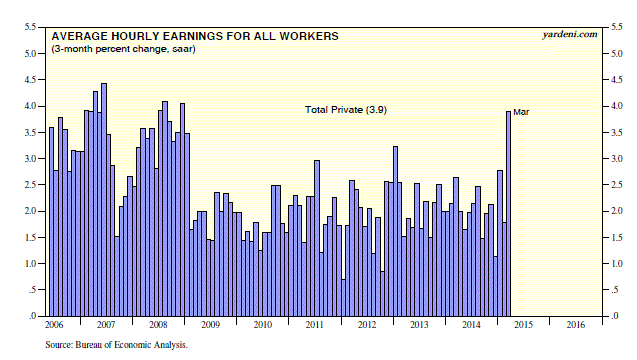
Last week, the 4/16 WSJ reported:
“U.S. wages may be starting to pick up, a development that could help policy makers at the Federal Reserve feel more confident that sluggish U.S. inflation also will gain traction, Fed Vice Chairman Stanley Fischer said Thursday.”
He said so on a panel discussion in Washington. That same morning, in a CNBC interview, he said the Fed knows the markets “look ahead somewhat, so I think--I hope--that they are taking into account that the Fed, at some point, is likely to raise the interest rate.” On timing, he said markets “can’t depend on the current situation continuing forever--or even probably--beyond the end of this year.”
He reiterated that “there are more signs every day” of mild wage increases. What is he looking at? Let’s have a look:
(1) Minimum wage. Anecdotally, the minimum wage was raised in 21 states at the start of the year. However, during March, average hourly earnings rose only 2.1% and 1.8% for all workers and for production and non-supervisory workers.
(2) McDonald’s. On 4/15, fast-food cooks and cashiers demanding a $15 minimum wage walked off the job in 236 cities in what organizers called the largest mobilization of low-wage workers ever. On April 1, McDonald’s (NYSE:MCD) announced plans to give employees a 10% pay bump and some extra benefits. The raise will affect about 90,000 workers at a small fraction of McDonald’s stores. Employees at franchises, which make up the majority of the burger chain's locations, won't be affected.
(3) Walmart. At the start of April, Walmart (NYSE:WMT) raised its minimum starting wage to $9 an hour, 24% higher than the federal minimum. A 4/10 story on PBS NewsHour noted:
“The company says that its wage increases will impact 500,000 workers, but the number who will see their wages rise from the federal minimum of $7.25 to $9 is much smaller. Only 5,000 of its 1.4 million workers actually make the minimum wage. And the minimum in most of the country, 29 states, is already considerably higher than the federal minimum. Seven states and the District of Columbia have minimums of $9 or higher. So the average pay raise for the affected Walmart workers will be far less than the 24% raise for the very small number currently earning the federal minimum.”
(4) Quit rate. The quit rate in retailing tends to be relatively high, especially among low-paid workers. Retailers are raising their wages to reduce their labor turnover costs.
(5) Q1 wages and prices. Average hourly earnings for all workers rose 3.9% (saar) during the first three months of the year, the highest since December 2008. That’s the kind of y/y increase that Fed officials have said would allow them to normalize monetary policy sooner and at a faster clip.
In addition, the core CPI inflation rate edged back up to 1.8% during March, closer to the Fed’s 2% target--which is really for the core PCED, which was 1.4% during February. The three-month annualized change in the core CPI through March was 2.3%, suggesting that the core PCED, which was 0.9% through February, might show a higher increase when March data are released on Thursday, April 30.
Today's Morning Briefing: The Twilight Zone. (1) Valuations on the border of the Irrational Zone. (2) Three fears hit market: Greek exit, China bubble, and inflation uptick. (3) Recapping stretched valuations. (4) Institutional investors remain skeptical. (5) Outperforming SMidCaps less exposed to dollar. (6) Shortage of bargains. (7) Buybacks = Corporate QE. (8) Corporate execs comparing earnings yield to borrowing rate when buying back shares. (9) Warning: Inflation may be warming.

